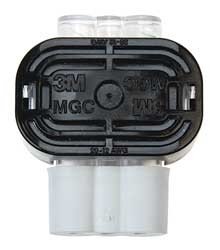Why is crimping preferred over soldering when joining wire to electrical
connectors and why do American Boat and Yacht Council Standards
specify that solder shall only be used in combination with crimping, except
in the case of battery cables?
To be sure, this subject still provokes heated discussion, especially among those who see
soldering of crimped joints as extra insurance of reliability.
Both mechanical and electrical integrity in the marine environment are essential to
reliable connections. The crimped joint provides both, if properly done. Reliable crimps
require that both wire and connector be of matching sizes, that proper tools are used, and
that the materials (wire and connectors) be of marine grade quality to begin with. A
combination wire cutter,stripper, and crimper is available at good hardware and marine
dealers. The crimping part of the tool actually comprises dies which exert a swaging
action on connector and wire, effectively created a "weld". The tool was designed to
confine the connector and wire so that the pressure exerted by the die was concentrated at
the joint. This is why ordinary pliers are not acceptable. They will crush the connector
barrel alright, but both connector and wire will squish out to the side, making a joint
which is mechanically weak, and electrically suspect.
A good crimping tool will have dies for both insulated and non-insulated connectors in at
least three sizes: #8-10, #12-14, and #16-18. it is important to make the crimp with the
right die.
If you are getting loose connections, or if you see cracks in the connector barrel or
insulation, you are using the wrong die.
Get a marine rated connector a your dealer's and carefully examine the inside of the
barrel which receives the stripped wire. Note the grooving which is designed to grip the
wire, preventing stretching, and focus the crimping pressure to effect welding action. The
crimp "work hardens" the copper of the connector so that the joint is mechanically sound.
Multi-stranded wire is required in marine applications (except when a heavy gauge, wellsupported,
dressed wire is used solely as a ground bus), made up of fine-stranded(e.g. 30
guage), pre-tinned wire for best results. Automotive hook-up wire is usually not pretinned,
and bare copper oxidizes (corrodes) in salt air.
Once a good electrical/mechanical joint is made, it is essential to protect it from water or
moist salt air. The best way to do this now is by using shrink tube insulation, especially
the type which includes a heat activated adhesive on the inner surface. The shrink tubing
is put on before the crimp is made, of sufficient length to overlap the wire insulation by a
1/2" or so. Application of heat (a heat gun used for striping paint will do) causes the
adhesive to liquefy and the tubing to shrink tight to the wire and connector.
But soldering is a time-honored method. What's wrong with it now?
Good soldering requires a certain technique. A cold soldered joint may be worse than
useless, since it may look OK to an unpracticed eye. Good soldering is especially difficult
when making up a splice in a confined or limited access space. Using a proper tool, a
good crimp is easy.
As mentioned, crimping action work hardens the connector barrel, making the joint
mechanical strong and stable. If you solder a crimped joint, you may, in heating the
connector, anneal(soften) the copper, making the joint loosen. Now it is the solder only
which provides the strength of the joint. But if the joint is subjected to vibration, the
solder, in absorbing mechanical energy over a period of time, may crystallize, and the
joint may actually fail altogether.
Melted solder may flow through "wicking" action up the strands of wire, thus creating a
stiff, solid section just behind a terminal. Since the terminal itself is made fast to a post or
stud, the place where the solder stiffened section abruptly merges with the stranded,
unsoldered wire is relatively unsupported. Vibrational flexing of the wire is concentrated
at this interface, leading to hardening, embrittlement, and eventual failure.
Contrary to popular belief, solder is not impervious to corrosion. It is a composition of
lead and tin. When connected to copper (wire and terminal) in a salt atmosphere, galvanic
corrosion can occur, resulting in leaching out of the lead, leaving a powdery residue
which is both electrically and mechanically worthless.
Whether crimped only or soldered and crimped, protection from salt atmosphere is
important. For wiring splices, shrink tubing is the way to go. For terminal strips, the are
liquid sealants available which can painted on after a connection is made up.
Recently, connectors which incorporate shrink-tube insulation sleeves have been
introduced to the consumer marine market. The connector-wire joint is first crimped, the
a heat gun is used to seal the connector insulation to the wire cover making a waterproof
joint. This would appear to be the best method for making up connections, especially
below decks, or in other salt atmosphere spaces.
It is rare when convenience and reliability are served by the same process. But crimped
connections, properly made up and protected from the environment offer the skipper both
ease and dependability. The local yard has even been crimping battery cables for the past
several years, using a special swaging tool.
Thanks to Lysle Gray, Technical Director, ABYC, Paul Michalczyk of ANCOR Marine,
and Jim Vaughn of FTZ Industries, all experts in marine wiring, for their consultations in
preparing this article.


